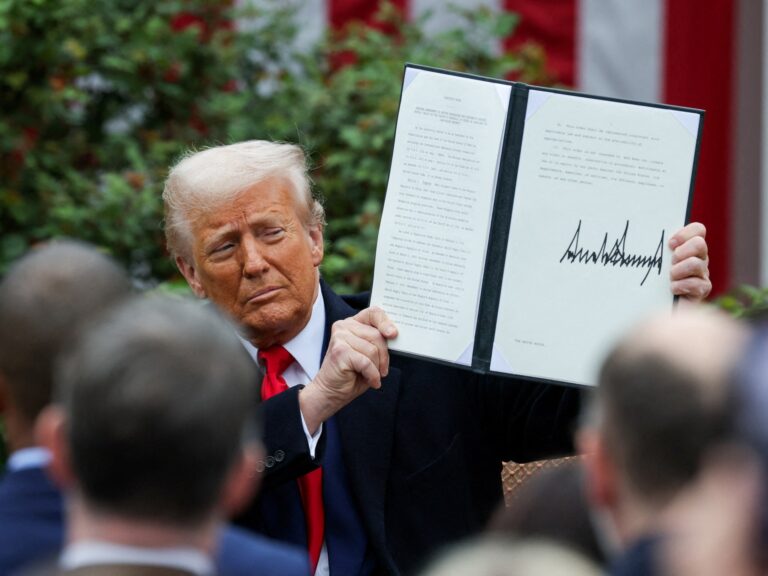At a White House dinner back in 2011, Steve Jobs was asked by President Obama what it would take to build iPhones in the United States. Jobs knew where this was going. “Those jobs aren’t coming back,” he replied. Supply chains and ecosystems that sustain manufacturing of hi-tech products like the iPhone take years to get going. The skills, capabilities and relationships that are involved take even longer to develop. Factories cannot simply be picked up from one place and transplanted into another.
President Trump decided to try, anyway. On “Liberation Day”, he announced sweeping tariffs, which were not reciprocal but based on the idea of balancing trade deficits.This has thrown the economy into turmoil and sent markets plunging – under pressure mainly from Wall Street, he delayed the higher tariffs for 90 days but ratcheted them up for China. Markets recovered somewhat but the uncertainty remains and might even have done some permanent damage already by being baked into the cost of capital.
Much analysis since the announcement about tariffs has focused on the formula used to calculate them, and the flawed understanding of economics that the new policy is based on. The formula for tariffs certainly does not measure what the president thinks it measures. Nor does it make sense for America to make everything itself. There are things that we buy in our individual lives without expecting the seller to buy something from us. And if a country tries to build everything, it cannot specialise. This means a decline in productivity and the country becoming less competitive in many areas that it would like to dominate.
Ceteris Paribus, imposing blanket tariffs will do more harm than good, but it is worth understanding the reason behind it. It is not that America is being “ripped off” by other countries. America’s competitiveness problem is rooted in the globalisation of production. More specifically, in the case of America, it is the “China syndrome” or the China Shock, terms coined by David Autor, David Dorn and Gordon Hanson in their 2013 paper. As a result of a flood of imports from China, an estimated two to three million US manufacturing jobs were lost between 1999 and 2011. Many more have been lost since then. Some areas, especially where industries competed head-on with China – in the Midwest and South – were hit hard.
These job losses were not offset by new jobs in the same regions, with the affected communities experiencing lower wages, higher unemployment and increases in opioid addiction, social instability, and political polarisation. Even workers outside manufacturing saw wage stagnation, especially those without college degrees, as the labour market became more competitive and bargaining power weakened. Promises that displaced workers could “learn to code” or move to tech jobs often failed. Many workers couldn’t easily retrain or relocate, especially older ones or those in distressed communities.
With globalisation, Wall Street has benefitted, but not Main Street. It is not just low-value-added products, however. America’s trade balance in advanced technology products is also negative. In 2024, it incurred a deficit of nearly $300 bn in that category. America has been borrowing to finance deficits and to continue consuming. This strategy is fundamentally unsustainable and something has to change.
Is imposition of tariffs on the whole world the answer to America’s competitiveness problems? It depends upon what America is trying to achieve through that. Is it leverage? Unfettered access to foreign markets? Or bringing all the jobs that it has outsourced over the years back?
On leverage, America might be able to cut some deals, but at the expense of American people’s purchasing power. It might also be able to get countries to lower some barriers to American exports, but I doubt that will save GM or Ford. And as for bringing jobs back, Commerce Secretary Howard Lutnick is now saying factories that return to the United States will be run mostly by robots!
Strongarming countries and companies into investing in America will only go so far. Transferring ecosystems around particular products takes many years. If America’s objective is to get its dominance in innovation, development and manufacturing back, slashing research funding across the board does not make sense, either. Going after university research eliminates the “commons” that all American corporations benefit from. It’s an own goal.
If the idea is to reverse the outsourcing corporations rely upon to generate wealth for investors, that’s like putting toothpaste back into the tube. How long is Trump willing to persist? Pressure is already mounting from powerful actors and fault lines are appearing within the Republican Party. China’s tit-for-tat stance is not helping. Tariffs are not likely to work for Trump, and persisting with this strategy and raising inflation will not do him any favours in the midterms, but the problem of Wall Street v Main Street will only get worse, and someone, whether Trump or his successors, will need to address it.
The views expressed in this article are the author’s own and do not necessarily reflect Al Jazeera’s editorial stance.

